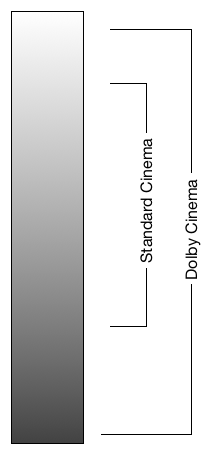Disney’s Tomorrowland opened at Disney’s El Capitan theatre in Hollywood this month, in Dolby Vision. This is the first opportunity given the general public to see a movie produced in EDR (Dolby’s preferred term for High Dynamic Range, or HDR) on the Dolby Vision laser projector. It is the start of a new trend in both cinema and home. Some background will be useful to understand the “dynamics” of this new technology.
Dynamic range in cinema refers to the range from dark to bright that the projector can display. The theoretical dynamic range of a digital cinema projector having a 1200:1 contrast ratio is 10 stops. Those familiar with photography may relate to the concept of the human eye’s compressed response to brightness, which can be described as near logarithmic. As a result, a doubling of brightness is described as one “stop.” This manner of discussing brightness is more in tune with how we see, than when we use numbers such as “1200:1 contrast ratio.”
It was shown that standard cinema at best can display 10 stops. Dolby Vision in cinema expands this number to an unspecified amount, probably in the 14-15 stop range for cinema. For home entertainment, Dolby has aspirations of reaching up to 20 stops. To compare the cinema case, Kodak’s Vision 3 color negative film stock, still hailed by certain motion picture directors as the ultimate in image capture technologies, will capture 13-14 stops. Dolby Vision in cinema in part achieves its large dynamic range by increasing the peak light level. In the Tomorrowland screening, the peak luminance was a bit over 100 nits. This is slightly over twice the peak luminance available for standard cinema, or just over one stop. To further expand the dynamic range, Dolby reduces the black level of the projector through a proprietary double modulation scheme. I have not seen any figures on this, but my estimate is that this adds 3-4 stops, producing a total dynamic range of 14-15 stops.
It is indeed the black level of the projector that is the signature of Dolby Vision. In standard cinema, white letters on a black background will appear as white letters on dark gray. In Dolby Vision, the black background is unquestionably black, and indistinguishable from a black surround. Of course, the black level will be impacted by the ambient light of the room. This, in fact, offers a partial explanation as to why Dolby has pursued its Dolby Cinema concept, where it can exercise greatest control over the ambient light in the room, and maximize the Dolby Vision experience.

A simple explanation of dynamic range in cinema
At the time of this writing, only one review of Tomorrowland in Dolby Vision has been seen in the press, and is worth reading (CNET raved about it.) Interestingly, the reviewer described the colors as more vivid, and relates this to laser illumination. In fact, the color gamut of the movie is DCI P3, as in any other cinema. What the reviewer more likely saw is the benefit of increased contrast ratio (which Dolby claims can be up to 1,000,000:1) due to the improvement in black level, enhanced by the extra stop in peak luminance (the peak luminance made possible due to laser illumination).
In practice, color and contrast cannot be separated. Color scientists discuss the subject of color appearance models, as it describes the interrelationship of parameters that influence our perception of color. Mark Fairchild of Rochester Institute of Technology (RIT) summarizes how these parameters interact in an online presentation. It is the fact that color appearance models are needed that underscores the complication of wide distribution of HDR movies in both home and in cinema.
Models are needed as the perception of color varies with luminance. This means that certain colors may vary when viewed on displays of different peak luminance values. With Dolby Vision in cinema, Dolby has fair control over content mastering, distribution, and the exhibition environment in which it’s shown. Dolby can determine peak luminance and control ambient lighting in its cinemas, for example. In home entertainment, however, the manufacturer determines the peak luminance of a display, and Dolby can only exercise control over how Dolby Vision is implemented. This creates a problem, and Dolby is prepared.
If HDR content is to be produced by multiple sources, and not just mastered by Dolby, then things get complicated. In cinema, it would require a new generation of standards to preserve creative intent with projectors of different peak luminance and display characteristics. Similarly in home entertainment, the problem can become quite complex. So complex that Dolby is hinging the success of the home entertainment version of Dolby Vision on its ability to properly match content from a variety of sources through its licensed technology. In cinema, the complexity could be self-limiting, due to the enormous cost of systems. Dolby could end up the only provider of HDR in cinema for some time.
But for all of the complexity required to get it right, it remains to be seen as to whether the audience will notice the improvements brought by Dolby Vision and any future look-alikes. The CNET reviewer of Tomorrowland most certainly felt it was the best thing he had seen. And Dolby and its exhibitor customers are betting that there are a lot more like him. But eyeballs in Hollywood are not representative of those elsewhere in the world. When Dolby Vision plays in Kansas – an event likely to happen, given that Kansas-based AMC Entertainment entered an agreement for Dolby Cinemas – a lot more will be learned.